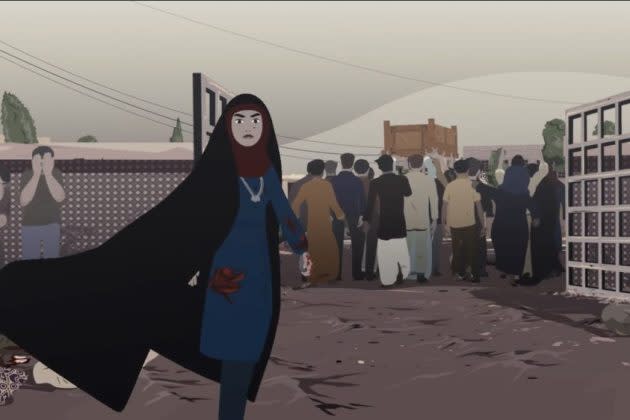‘The Siren’ Review: A Soulful Animated Adventure Set During the Iran-Iraq War and Tinged With Magical Realism

Using clean lines, a controlled color palette and a flattened 2D drawing style, Sepidah Farsi’s engrossing Berlin Panorama opener “The Siren” paradoxically creates a story rich with dimensional detail and riven with the tragedy of war. Much like Marjane Satrapi did with 2007’s “Persepolis,” Farsi uses animation as a way to set the acutely painful civilian experience of the Iran-Iraq conflict at enough of a remove to make it bearable: From a distance, like a floating overhead angle or a wide cityscape vista, even smoke clouds and flying rubble can acquire a sort of beauty.
Unlike Satrapi’s film, however, “The Siren” leans into the form’s fictionalizing possibilities until it becomes less an illustrated snapshot of life in post-revolution Iran than a kind of wish-fulfilment fantasy, such as might have been dreamed up by a teenager, in which resourcefulness, resilience and fellowship eventually win out over forces of oppression and violence. Part of what makes it engaging, and a lot of what makes it exciting, is that “The Siren” doesn’t ring quite true.
More from Variety
'The Teachers' Lounge' Review: Lessons Are Taught and Taut in a Gripping Classroom-Ethics Thriller
French Documentary 'On the Adamant' Wins Golden Bear at Berlin
It is 1980 in Abadan, an oil port in the south of Iran and Omid is 14 years old, as evidenced by a wispy scraggle of mustache that gradually grows in as the months pass. Posters of the newly installed Ayatollah deck the peeling walls downtown, which sits in the shadow of a massive oil refinery. Omid is playing soccer with his friends, defending against a penalty, when he is distracted by a spray of missiles arcing across the sky. The ball goes in the net, and the skyline explodes.
Running home through the confusion, Omid spots his beloved elder brother Abed leaving on a transport for the frontlines as part of a hastily formed militia. He wants to join up as well, but is forbidden by his tearful mother, who instead reluctantly allows him to stay behind to look after his elderly grandfather and the family’s palm groves, while she and his younger siblings flee to a less perilous region.
For a time, a new normal reigns. Omid continues training his rooster Shir Khan for his cockfighting debut. He listens to his granddad’s stories about his father, the captain of a lenj (a large traditional wooden boat) who was lost at sea years before — cuing some of the film’s more overtly magical-realist dream sequences. And he mucks about with cynical delivery-man Farshid, a Han Solo-type whose first impulse after Omid saves his life following a bomb-related car crash is to bemoan the fact that Omid and Pari, the pretty stranger who used her headscarf as a tourniquet on his wound, have “fucked up my martyrdom.”
With Farshid laid up in hospital, Omid takes over his route, dodging flying shrapnel on his motorbike to distribute tureens of biryani cooked by a jolly local chef to the increasingly ragtag remaining residents of Abadan. There’s the eccentric engineer who lives at the top of of a ruined tower block on the outskirts among dozens of rangy cats. There are the two Armenian Orthodox priests who have remained cloistered in their church to protect an icon of the Virgin. And there’s Elaheh, the reclusive once-famous singer (an amalgam of several similar real-life figures) who has not been allowed to perform since the overthrow of the Shah, and who happens to be, conveniently for a tentative romantic storyline, Pari’s mother.
In designer Zaven Najjar soothingly simplified animation style, under Erik Truffaz’ lovely, traditionally-inflected but also jazzy score, all the characters are sketched with a loving eye for their eccentricities. To an almost excessive degree, perhaps: At times, it can seem a little like Abadan in 1980/81 was populated exclusively by nostalgic romantics, quirky rapscallions, curmudgeonly colonels, three-legged dogs and limping, plump teenagers who keep doves as pets. The schematic nature of all this colorful characterization becomes especially apparent when Omid realizes the city is about to fall to the Iraqis, and hits on a Noah’s Ark-style escape plan, a desperate Hail Mary that can only work if each of his acquaintances supplies one vital part of the puzzle.
But if it’s all a little contrived, it’s also undeniably moving, as Omid comes to realize that not all heroics in war are performed by soldiers with guns. Instead, he begins to understand that when under siege, qualities like decency, kindness and a little gallows humor can be more valuable than the impulse to sacrifice yourself on the field of battle. Omid becomes a custodian of life in a zone of death — even feeding spoiled ice cream to the starving sharks in the bay, who have had little to eat since the normally busy waterway fell silent.
It is in such moments, perhaps more so than in its overarchingly tall tale, that “The Siren” itself feels most alive: when the Iranian guards on lookout duty and their Iraqi opposite numbers all cease fire to watch the same TV show; when the figure of Elaheh, spied through binoculars, stays the enemy’s command to fire; when, even though its buildings are reduced to piles of debris and so many of its inhabitants lie dead, a city finds the spirit to survive.
Best of Variety
Sign up for Variety’s Newsletter. For the latest news, follow us on Facebook, Twitter, and Instagram.
